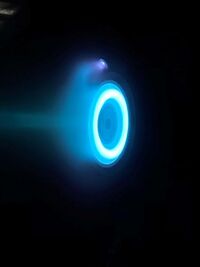Engineering:SPT-140

SPT-140 is a solar-powered Hall-effect ion thruster, part of the SPT-family of thrusters. SPT stands for Stationary Plasma Thruster.[1][2] Like other members of the SPT series, it creates a stream of electrically charged xenon ions accelerated by an electric field and confined by a magnetic field.[3]
The thruster is manufactured by the Russian OKB Fakel, who collaborated during development with NASA's Glenn Research Center, Space Systems Loral, and Pratt & Whitney beginning in the late 1980s.[4][5] It was first tested at the Plasmadynamics and Electric Propulsion Laboratory in 1997.[6] In 2002, it was tested as a 3.5 kW unit by the United States Air Force as part of its Integrated High Payoff Rocket Propulsion Technology program.[7] In 2023, the thruster was launched aboard NASA's Psyche spacecraft.[8]
Specifications
| SPT-140 | Parameter/units [9][10] |
|---|---|
| Type | Hall-effect thruster |
| Power [11] | Max: 4.5 kW Min: 900 watts |
| Specific impulse (Isp) | 1800 seconds |
| Thrust | 280 mN[10] |
| Thruster mass | 8.5 kg |
See also
References
- ↑ Agle, D. C.; Russell, Jimi; Cantillo, Laurie; Brown, Dwayne (September 28, 2017). "NASA Glenn Tests Thruster Bound for Metal World". NASA. https://www.jpl.nasa.gov/news/news.php?feature=6958.
 This article incorporates text from this source, which is in the public domain.
This article incorporates text from this source, which is in the public domain.
- ↑ Lord, Peter W.; van Ommering, Gerrit (2015). "Evolved Commercial Solar Electric Propulsion: A Foundation for Major Space Exploration Missions". 31st Space Symposium, Technical Track, April 13–14, 2015, Colorado Springs, Colorado. http://2015.spacesymposium.org/sites/default/files/downloads/P.Lord_31st_Space_Symposium_Tech_Track_paper.pdf. Retrieved January 6, 2018.
- ↑ Sankovic, John M.; Hamley, John A.; Haag, Thomas W. (1993). "Performance Evaluation of the Russian SPT-100 Thruster at NASA LeRC" (PDF). https://ntrs.nasa.gov/archive/nasa/casi.ntrs.nasa.gov/19940019157.pdf. Retrieved 26 January 2017.
- ↑ "Native Electric Propulsion Engines Today" (in ru). Novosti Kosmonavtiki. 1999. http://novosti-kosmonavtiki.ru/content/numbers/198/35.shtml.
- ↑ Delgado, Jorge J.; Corey, Ronald L.; Murashko, Vjacheslav M.; Koryakin, Alexander I.; Pridanikov, Sergei Y. (2014). "Qualification of the SPT-140 for use on Western Spacecraft". 50th AIAA/ASME/SAE/ASEE Joint Propulsion Conference, July 28–30, 2014, Cleveland, Ohio. doi:10.2514/6.2014-3606. AIAA 2014–3606.
- ↑ "SPT-140 | UM PEPL" (in en-US). https://pepl.engin.umich.edu/project/spt-140/.
- ↑ "T-140". University of Michigan Plasmadynamics & Electric Propulsion Laboratory. http://pepl.engin.umich.edu/project/t-140/.
- ↑ Lewis, Briley (2023-10-17). "NASA's Psyche spacecraft will blaze an unusual blue trail across the solar system" (in en-US). https://www.popsci.com/science/nasa-psyche-hall-thrusters/.
- ↑ Myers, Roger. "Solar Electric Propulsion: Introduction, Applications and Status". Aerojet Rocketdyne. http://sites.nationalacademies.org/cs/groups/depssite/documents/webpage/deps_085382.pdf.
- ↑ 10.0 10.1 Johnson, Ian K.; Kay, Ewan; Lee, Ty; Bae, Ryan; Feher, Negar (2017). "New Avenues for Research and Development of Electric Propulsion Thrusters at SSL". 35th International Electric Propulsion Conference October 8–12, 2017 Atlanta, Georgia. IEPC-2017-400. https://iepc2017.org/sites/default/files/speaker-papers/iepc_2017_ssl_electric_propulsion.pdf. Retrieved January 6, 2018.
- ↑ "Development of the Psyche Mission for NASA's Discovery Program". https://iepc2017.org/sites/default/files/speaker-papers/iepc-2017-153_psyche_mission_overview_final_0.pdf.
This article needs additional or more specific categories. (October 2023) |
 |

